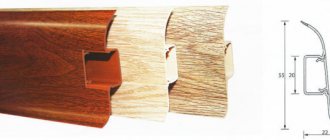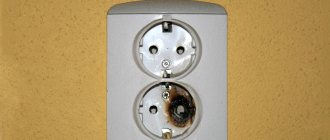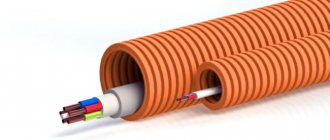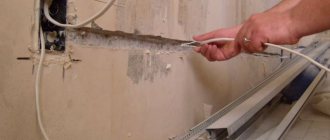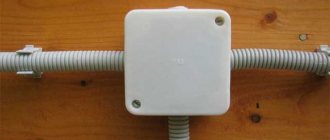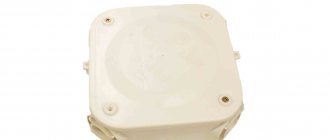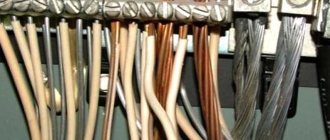Pros and cons of electrical wiring in baseboards
First of all, hidden elements of communication are aesthetically pleasing, especially when it comes to ceilings. However, there are other advantages of ceiling plinths with cable duct:
- easy and convenient access to wires is an invaluable advantage when it is necessary to replace a cable, detect a fault or an overheated area;
- simplicity of the technology - the installation is easy to do with your own hands; laying the cable does not require violating the integrity of the walls, breathing concrete dust and wasting effort on restoring the finish after the groove;
- a variety of design options - from fastening methods to the number of cable channels;
- disguising wires from unauthorized persons - it will be more difficult for an attacker to find hidden alarm lines, video surveillance switching, communications and television;
- a variety of materials, shapes, textures and colors - it’s easy to choose products to match the appropriate interior style;
- ease of repair and maintenance of skirting boards.
The presence of disadvantages is due to the physical properties of some materials:
- the design of some models makes it difficult to open cables without damaging the fasteners;
- budget PVC skirting boards are too fragile and can crack when screwing in self-tapping screws; in addition, they fade over time;
- flexible edges that provide a tight fit to uneven walls can subsequently lose elasticity and move away from the surface, forming cracks.
How to choose
Neat ceiling plinth with cable duct allows easy access to wires
Instructions for choosing a plastic ceiling plinth with a cable channel suggest:
- Select the color of the product to match the floor, walls or ceiling, slightly changing the shades, or give preference to a contrasting option.
Molding to match the color of the walls
The main condition is the taste of the owner and ensuring comfort in the room.
- The size of the plinth is influenced by the volume of the room, the height of the ceilings, and the number of utilities that need to be hidden.
In addition to wires, lighting equipment is also installed in the baseboards.
Tip: When purchasing a product, you should opt for the option with large sizes so that there is enough space for all the cables.
- When choosing a material, you need to pay attention to the quality of the mounting strip; it should be flexible and not break due to slight misalignment. The latches are checked, which should securely and tightly close the recess located on the front side.
Tip: When choosing MDF molding, you need to pay attention to the melamine coating so that it is of good quality.
Types of ceiling cable channels
Let us consider in detail the existing options for skirting boards and the materials that are used for their manufacture, since not all of them allow the use of this decorative element as a ceiling cable channel.
Wooden skirting boards
Wood is good for its environmental friendliness and durability, but it is fire hazardous. Low-current communication channels, alarms, video cables and similar communications can be hidden under a wooden baseboard, but other materials are used to lay power electrical cables to avoid fire. Also, due to its high hygroscopicity and susceptibility to fungal infections, wood cannot be used inside wet rooms.
Depending on the appearance of the front side of the product, there are:
- classic plinth;
- versatile;
- fillet;
- europlinth.
There are also other, rarer types of decor. They are made from solid wood or spliced timber of various species, most often from pine, oak, beech, linden or larch.
Source: potolok.expert
How to properly hide all cables in the baseboard and forget about them
Today there are several ways to conduct electricity. Electrical wiring may run inside walls. This creates extreme inconvenience during repair work.
Another option for cable routing is cable routing in the baseboard. This method allows you not to spoil the appearance of the room.
Features of skirting boards with cable channel
If previously electrical cords had to be laid in the walls, making special grooves, then modern construction technologies make this much easier. The grooves and laying of surface channels for wires, which spoiled the appearance of the room, were replaced by compact and convenient plinths with a cable channel. They allow you to deal with annoying cables quickly and aesthetically.
Thanks to a special groove for electrical cords, the baguette becomes an indispensable element of room decor
Skirting boards with a cable channel: advantages
Planks in which you can hide wires are undoubtedly a real boon for interior design. Their advantages:
- concealment and protection of unsightly cords;
- easy installation;
- aesthetic appearance;
- ease of care;
- various designs, colors.
Baguettes in which cables can be laid are universal: they not only hide the wiring, but also have an attractive appearance that matches the design of the room.
Types of frames with a groove for wires
According to the type of design, channel edging is divided into:
- plinth with a hidden cable channel, which is covered with a decorative strip. This type of baguette is used most often, but has a drawback - the groove for the wires is quite narrow;
- a fillet with a removable upper part in which the cords are laid. This type is more suitable for masking thick cables, but in appearance it is inferior to the first.
Types of fillet designs
Cable plinth can be made from various materials. The most common is plastic. PVC plinth with cable duct bends well, and thanks to the rubberized edges it fits tightly even to uneven walls. The product is easy to maintain, unpretentious in operation, and easy to clean. Plastic floor plinth with cable duct has many colors, it does not fade in the sun and does not require painting.
A plastic frame with a groove for wires will organically fit into any room design
Remember: a plastic product is quite fragile - it is better not to hide thick massive cords in it (they can tear out the top bar).
Types of skirting boards for cables
There are two types of wire trays:
- The product has a recess on the front side. The cable fits into it. After which the groove is closed with a compact lid. It can be quickly removed and returned. A good option in case new wiring is added in the future, but you don’t want to remove the entire baseboard.
- Initially, only the tray is attached to the wall. A wire is attached to it. A massive front cover is placed on the structure. The assembly turns out to be more durable and capital. Suitable for families with small children, because getting to the cables is not so easy.
Technology for installing fillets with a groove for wires
How to lay a cable in the baseboard? You can do this yourself. Let's look at the example of laying a plastic baseboard with a cable channel. The length of the product is 2.5 m, this is the most compact size for transportation and installation. Various corners and connectors are also supplied with the planks.
The first step is to mark the room. Marks are placed both on the walls and on the baguettes.
Marking work before installing planks
Next, the parts are cut and adjusted to the required dimensions. It is not necessary to make diagonal cuts to form corners - they will be covered with special overlays.
Tip: cut the baguettes carefully so as not to damage their edges. To do this, it is preferable to use a hacksaw with fine teeth.
Cutting planks in a miter box
Installation of the plinth with cable duct is carried out from the inner corner of the room, located near the front door. First, holes are drilled along all the walls for attaching the plinth in increments of 40-50 cm. They are made at the level of the groove for the wires (1-3 cm from the floor).
Then the decorative strip is separated from the baseboard, and the main strip is attached to the wall using self-tapping screws. Holes in the fillets can be marked with an awl.
How to lay wires in the baseboard? Those cords that you do not need frequent access to are laid deep in the channel, and the most necessary cables are located on top. At the end, the groove is covered with a decorative strip.
Sequence of fastening a plinth with a cable channel
Note: the removable top bar is convenient because you can remove it at any time and add or reduce the number of cables.
Baguettes in which you can hide wires are a real godsend when decorating interiors. They allow you to hide wiring, cords and cables from household appliances, protecting them from mechanical damage and contamination. This irreplaceable detail of the room's interior brings convenience and beauty to our lives.
Source: thewalls.ru
Profile device
The structure of any cable plinth includes two elements: a cavity for wiring and a cover. The structure fits tightly to the floor and walls. This is necessary to protect the wires from dust and moisture when cleaning. Fastening is carried out using self-tapping screws or dowel-nails 20-40 mm long.
Materials and sizes
Wood, aluminum, PVC plastic or MDF are used in production. These materials are equally easy to install and adjust to the required size. The plastic version is somewhat more durable due to its increased resistance to moisture. Wooden and MDF products are among the most expensive.
The standard size is considered to be a length of 2.5 m. The height and width depend on the cross-section and the number of wires laid in it.
Fire safety
Improperly installed electrical wiring is a common cause of fire. Therefore, reliable manufacturers of cable skirting boards include substances that prevent combustion and smoke emission. The most heat-resistant material is aluminum.
Popular options for hiding wiring in an apartment
You can hide wires and cables from view using improvised means that are found in almost every apartment. Stores also sell special devices and solutions to this problem.
In decorative boxes
There are special decorative skirting boards that differ in their special design and performance characteristics. They have a cable channel in which the cords are located. The materials from which skirting boards are made can be different:
- Plastic - located at the base of the floor, there are special separating cells on the profile rail, thanks to which several types of wires are laid.
- The tree is quite rare. As a rule, wooden boxes are made to order. Their insulation class must be appropriate to avoid fire during use.
- Aluminum is most preferred. It is highly resistant to fire and accommodates a large number of powerful wires.
Hide the junction box
According to the rules, the junction box cannot be hidden under finishing materials. Access to it must always be free for maintenance and repair. Therefore, the white lid can be painted to match the color of the walls or covered with wallpaper. So that the plug does not stand out from the overall interior, it is also painted with automotive enamel to match the tone of sockets and switches.
Where to hide under the floor or near the baseboard
Wires lying around on the floor can be hidden under the floor. But this is done during repairs, because lifting floorboards or covering elements separately is a labor-intensive process.
Many people prefer the finish in its original form.
Wiring is often hidden in a special panel; it is mounted on the wall along the baseboard and is not noticeable.
In addition, it can be decorated or painted.
If masking occurs during repairs, then a hole is made in the floor using a hammer drill, then the wire is inserted into the corrugation and laid in the hole made. After which the floor is filled with cement.
Unusual options for decorating wires
In order to hide wiring from view, it is not necessary to break walls and ceilings, buy panels or decorative boxes.
If you use your imagination, the cords can be beautifully placed on the wall.
For example, here are a few original solutions.
How to decorate on the wall from an antenna or tuner
If you approach camouflage creatively, wires can become an unusual decorative element. They are able to enliven the atmosphere or interior as a whole. To do this, it is enough to purchase special clamps, which are made in various forms. For example, construct something like a tree branch from a cord using leaf-shaped clips.
If the wall is bare and the wire is long enough, then make a drawing on the wall. Draw a car, a cityscape, a road or a fence. Special stickers for the wall will dilute the design and give it completeness.
How to close on the wall
You can cover the wiring using various decorative elements for the wall: photo wallpaper, paintings. A bookshelf with a cord behind it will look original and beautiful. Using design techniques it is possible to decorate a wall in an original way:
- The loft style will be complemented by cable channels, which are designed in the form of bricks.
- The classic interior involves wood finishing. Panels and additional elements made of wood will not be superfluous.
- In a high-tech room, wires in the form of pipes secured with nails or screws would look appropriate.
How to hide a junction box on the wall
Since there must be free access to the junction box, it cannot be completely closed. But there are original solutions that will make it a decorative element:
- hang a decorative plate, poster or small picture on the lid;
- replace the standard box with a decorative one, which can be bought at any electrical store;
- decorate the cover with stickers designed to decorate sockets and switches.
How to hide wires on the wall beautifully from hanging light bulbs
Spot lighting in apartments is now popular, but hanging light bulbs have long cords that spoil the appearance of the room.
They are masked using special panels, which are sold in any hardware stores. They come in different colors and shapes, so it's easy to choose the right style.
If the wire is long, then using special fasteners, they create original patterns on the ceiling or wall. Decorated with additional accessories and stickers.
When does it make sense to groove cells on a wall or ceiling?
Grilling a wall or ceiling will be needed in the following cases:
- To lay long cords and cables stretching across the entire apartment, which are not possible to beat.
- If there are too many electrical devices in the apartment.
- For security. Children and pets can reach cords, even those hidden behind panels and stickers.
- Categorical denial of the presence of wiring elements in the interior.
A modern apartment consists of many communications, where electrical wiring occupies one of the first places. It connects not only light sources, but also all equipment and digital devices.
The abundance of cords creates a not very pleasant appearance, and if there are children in the apartment, then it also poses a danger. To avoid troubles, when planning a repair, you should think about how to hide the wires. In addition to internal camouflage, external camouflage is often used. The modern market offers a wide selection of various elements and accessories for these purposes.
